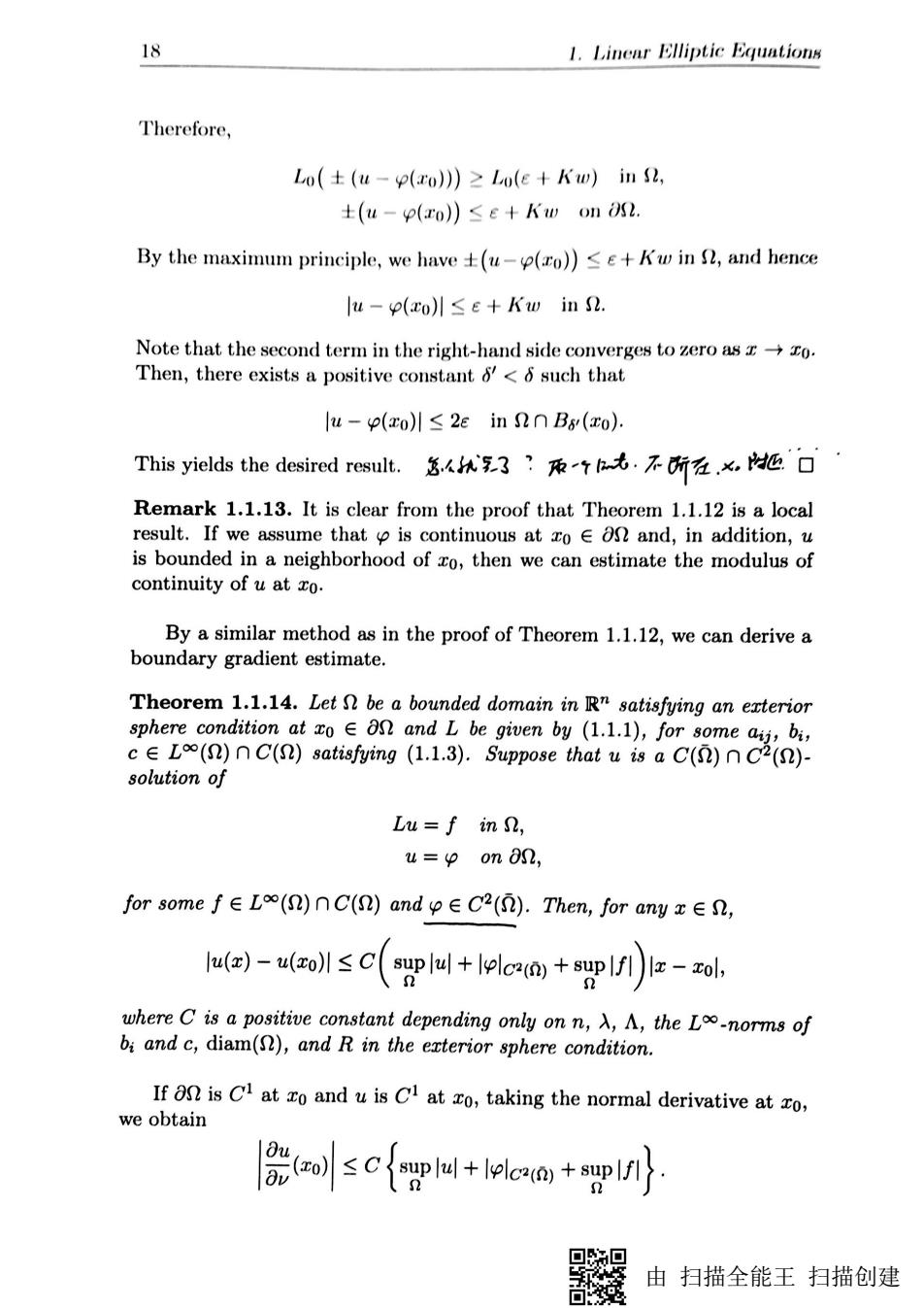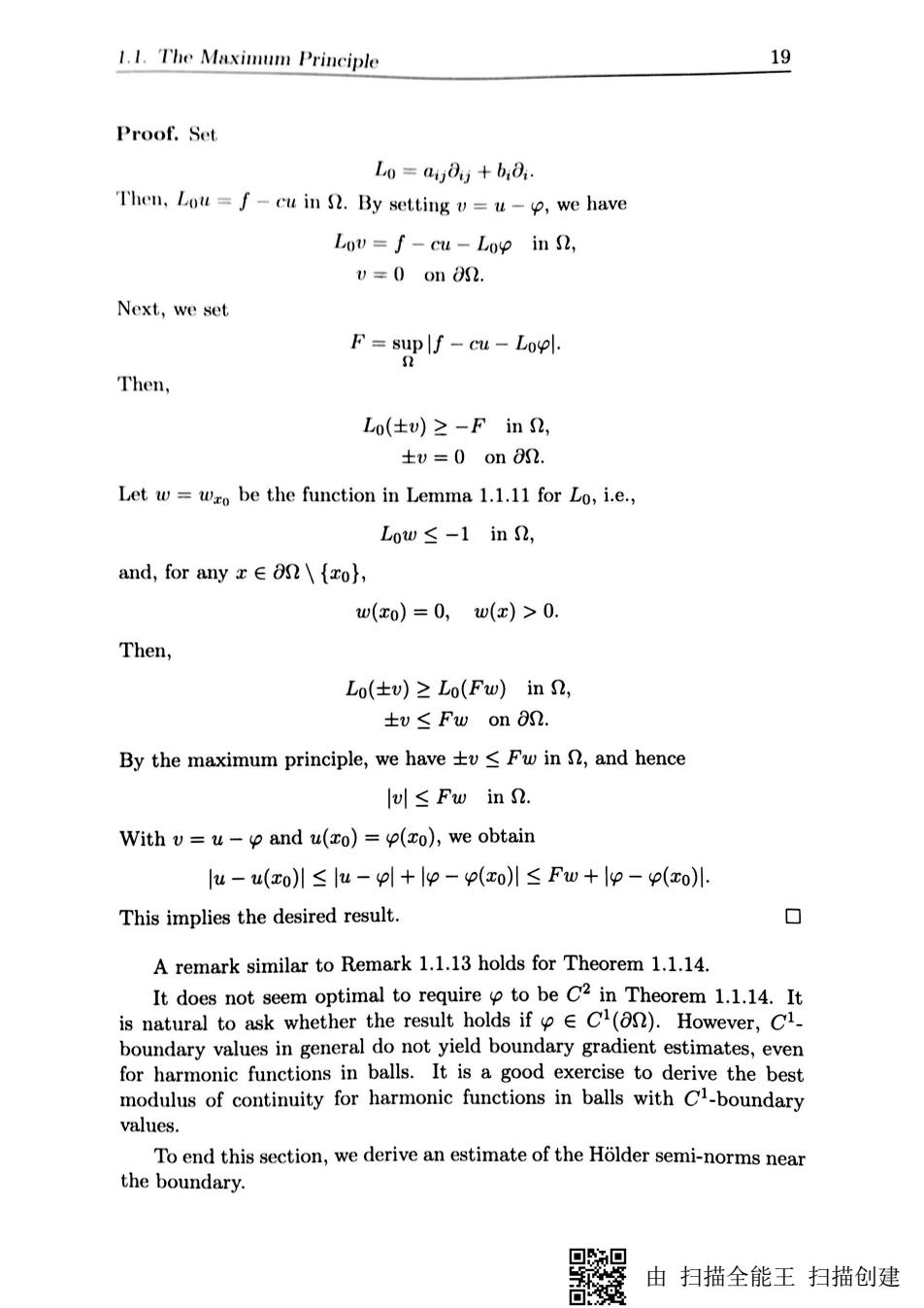
1.1.The Maximum Principle 17 Theorem 1.1.12.Letbe a bounded domain in R satisfying an exterior g有Cs。sphere condition at xo∈8 and L be given by(1.l.l),for some a,bi c()satisfying (1.1.3).Suppose that u is a C()()- solution of Lu=f inn, u=on as, for some feL()nC()andpC(a.Them,for any z∈, |u(x)-u(xo)川≤w(x-xol), wherewis anondecreasing continuous function inD),with D-diam() and limw(r)=0,depending only on n,A,A,the Lo-norms of bi and c diam(),R in the exterior sphere condition,supmaxsup and the modulus of continuity ofp on 8. Proof.Set L0=a0j+b10, Then,Lou=f-cu in 9.Let w=wo be the function in Lemma 1.1.11 for Lo,i.e., Low≤-1in2, and,for any zeon\{ro}, w(xo)=0,w(x)>0. We set F=sgPf-c4,重=mxol. Then, Lo(±u)≥-Fin2. Let e be an arbitrary positive constant.By the continuity of at o,there exists a positive constant 6 such that,for any eBs(o), lp(x)-p(xol≤e. We then choose K sufficiently large so that K>F and Kw≥2Φon8n\B(xo: We point out that K depends on e through the positive lower bound of w on as\Bs(xo).Then, Lo(Kw)≤-Fin2, 1+k3F可. and lp-p(ro训≤e+Kw on s.为hn4外专衣.· 由扫描全能王扫描创建 ▣
由 扫描全能王 扫描创建

18 1.Linear Elliptic Equations Therefore, Lo(土(u-p(ro))2Iw(e+Kw)in2, ±(u-p(o)≤e+Kwon2. By the maximum principle,we have土(u-p(ro))≤e+Kw in S,and hence u-p(xol≤e+Kwin2. Note that the second term in the right-hand side converges to zero. Then,there exists a positive constant 6'<6 such that lu-p(xo川≤2 in n Bs(xo. This yields the desired result.怎人k3:币Th大.不所在.x,地口 Remark 1.1.13.It is clear from the proof that Theorem 1.1.12 is a local result.If we assume that is continuous at zo on and,in addition,u is bounded in a neighborhood of ro,then we can estimate the modulus of continuity of uat zo. By a similar method as in the proof of Theorem 1.1.12,we can derive a boundary gradient estimate. n10品a加a c L()nC(S)satisfying (1.1.3).Suppose that u is a C()nC2(S)- solution of Lu=f in, u=p on 8s2, for some f∈L()nC(2)andp∈C2().Then,for any x∈, lu()-u(zol≤C(sp|4+lo+sup lfl)lz-zol, where C is a positive constant depending only on n,A,A,the L-norms of bi and c,diam(),and R in the exterior sphere condition If on is Cl at zo and u is Cl at ro,taking the normal derivative at zo, we obtain |器sc{pu+cam+P川 由扫描全能王扫描创建
由 扫描全能王 扫描创建

1.1.The Maximum Principle 19 Proof.Set. L0=a40,+b0. Then,Lou =f-cu in S.By setting v=u-,we have Lov f-cu -Lop in S, v=0on82. Next,we set F=sup lf cu-Lopl. Then, Lo(±w)≥-Fin2, 土v=0on0n. Let w=wro be the function in Lemma 1.1.11 for Lo,i.e., Low≤-1in2, and,for any x∈an\{xo, w(xo)=0,w(x)>0. Then, Lo(±v)≥Lo(Fw)inn, ±v≤Fw on 8s. By the maximum principle,we have t<Fw in and hence lul≤Fw in S. With v=u-and u(ro)=(co),we obtain lu-u(xo)l≤lu-pl+lp-p(xol≤Fw+lp-p(xo儿 This implies the desired result. A remark similar to Remark 1.1.13 holds for Theorem 1.1.14. It does not seem optimal to require to be C2 in Theorem 1.1.14.It is natural to ask whether the result holds if C(on).However,C1_ boundary values in general do not yield boundary gradient estimates,even for harmonic functions in balls.It isa good exercise to derive the best modulus of continuity for harmonic functions in balls with Cl-boundary values. To end this section,we derive an estimate of the Holder semi-norms near the boundary g 由扫描全能王扫描创建 ▣
由 扫描全能王 扫描创建

20 1.Linear Elliptic Equations Theorem1.l.l5.Leta∈(0,l)be a constant,,bea bounded domain in "satisfying an erterior sphere condition at o and L be given by (1.1.1),for someC()satisfying (1.1.3).Suppose that u is a C()C2()-solution of Lu=f in n, u=o on 8n, for some f∈L∞()nC(2)andp∈C(a2)satisfying,for any x∈a2, lp(x)-p(xol≤重alz-xol, for some positive constant a.Then,for any E, )-o训≤c(pl国+。+pl)-la, whereCisa positive constant depending onlyn,A,the L-nom of bi and c,diam(S),and R in the exterior sphere condition. Proof.Set Lo=aij8ij+bi0i. Then,Lou f-cu in 1.Next,we set M=9M.F=8P/-o4 Hence, Lo(±(u-u(xo))≥-Fin2. Now,we take a ball BR(yo)C R"such that nBR(yo)={ro}.Then,for anyrR),we take yR such that B(y)={o).Note that r<l-yl <2r for any xenn B2r(y). For any zeannB2r(y),we have lu(x)-u(xol≤重alz-xole≤(3r)Φa, where we used the triangle inequality lx-col l-yl+ly-zol 3r.On nnBzr(y),we simply have lu-u(xol≤2M Therefore, Lo(±(u-u(xo))≥-F in nB2r(y), ±(u-u(xo)≤(3r)Φaon8nnB2(y), ±(u-u(xo)≤2 M on snaB2r(). It is worth pointing out that r will vary later on. 由扫描全能王扫描创建
由 扫描全能王 扫描创建